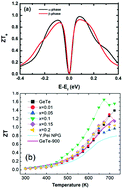High thermoelectric performance by chemical potential tuning and lattice anharmonicity in GeTe1−xIx compounds†
Abstract
We investigated the thermoelectric properties on the GeTe1−xIx (x = 0.0, 0.01, 0.05, 0.1, 0.15, and 0.2) compounds. From the electronic band structure calculation and thermoelectric properties, iodine doping can be regarded as an interstitial doping as well as a substitution at the Te-site, showing a degenerated p-type behaviour. The temperature-dependent electrical resistivity ρ(T) shows a broad shoulder near 450 K due to band convergence between light L- and heavy Σ-bands, which becomes significant with increasing iodine doping concentration. We also found the structural phase transition at 690 K for GeTe and at 650 K for the iodine-doped compounds. In a previous report, the high thermoelectric performance in doped GeTe is attributed to the band convergence effect associated with the structural phase transition. From the Boltzmann transport calculation, the enhancement of high thermoelectric performance is mostly related to the lattice anharmonicity, causing the low lattice thermal conductivity with a high Grüneisen parameter Γ (3.41) as well as the band convergence and structural phase transition effects, resulting in the high thermoelectric figure-of-merit (ZT 1.7 at 673 K) in GeTe1−xIx (x = 0.1).



 Please wait while we load your content...
Please wait while we load your content...